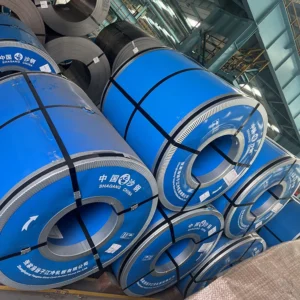Electrical Steel: The Cornerstone of Efficient Power and Electrification Technologies
In the global push toward electrification, smart energy infrastructure, and carbon neutrality, few materials are as pivotal as electrical steel. This engineered material, developed to optimize magnetic properties, forms the backbone of power transformers, electric motors, and generators. Its unique combination of high permeability and low energy loss makes it indispensable for modern energy systems across Europe and the Middle East.
Electrical steel not only supports technical performance and efficiency in critical power equipment but also directly contributes to climate goals through energy conservation. This article provides a deep dive into its properties, production, applications, and emerging trends shaping its future.
What Is Electrical Steel?
Electrical steel, often called silicon steel or lamination steel, is a specialty steel engineered to exhibit superior magnetic properties. It contains a high percentage of silicon (typically 1.5–3.5%) and is processed to enhance electrical resistivity and reduce core losses.
There are two principal categories:
- Grain-Oriented Electrical Steel (GOES):
Designed for transformer cores, with grains aligned in one direction to improve efficiency along the rolling axis. - Non-Grain-Oriented Electrical Steel (NGOES):
Used in rotating electrical machines such as motors and generators, offering consistent magnetic properties in all directions.
The magnetic efficiency and reduced energy loss of electrical steel make it the material of choice for energy transmission and conversion devices worldwide.
Key Properties of Electrical Steel
Electrical steel’s performance hinges on several core characteristics:
- High Magnetic Permeability:
Facilitates magnetic field induction with minimal energy loss. - Low Core Loss:
Reduces energy waste during magnetization cycles, lowering operational costs and carbon emissions. - Low Coercivity:
Requires minimal energy to magnetize and demagnetize, vital for AC equipment. - Surface Insulation Coating:
Helps suppress eddy current losses between stacked lamination layers. - Thermal Stability:
Maintains magnetic performance across a wide temperature range, critical in heavy-duty industrial or grid environments.
These properties collectively contribute to improved electrical efficiency and longer equipment lifespan.
How Electrical Steel Is Manufactured
Producing high-quality electrical steel involves several tightly controlled steps:
- Steelmaking and Alloying:
Silicon is added to enhance electrical resistivity and magnetic performance. - Hot Rolling:
Steel slabs are flattened into intermediate sheets under high temperature. - Cold Rolling:
Further reduces sheet thickness and refines the grain structure. - Annealing and Decarburization:
Heat treatments eliminate carbon and align grains (especially for GOES). - Secondary Recrystallization (GOES only):
Refines the crystal structure to a uniform orientation for magnetic performance. - Coating:
A non-conductive layer is applied to each sheet to reduce inter-laminar losses. - Domain Refinement (Optional):
Laser or mechanical treatments are sometimes used to reduce magnetic domain size and core loss.
This precision-controlled process ensures electrical steel meets the specific requirements of different end uses.
Applications of Electrical Steel
1. Transformers
Electrical steel is the core material in distribution and power transformers. Using GOES enables lower core loss, higher efficiency, and improved thermal stability, essential for grid reliability and energy conservation.
2. Electric Motors
From HVAC units to electric vehicles, NGO electrical steel is used in motor cores to enhance performance and energy efficiency. Lightweight, high-speed motors benefit from thinner-gauge NGO grades.
3. Generators
In both renewable and conventional energy plants, electrical steel reduces heat generation and boosts output in generators, supporting stable, low-loss electricity production.
4. Smart Grid Infrastructure
Modern energy systems rely on high-efficiency reactors, inductors, and voltage regulators—all of which use electrical steel to ensure reduced loss and thermal resilience.
5. Household and Industrial Appliances
Appliances like compressors, washing machines, and induction cookers benefit from reduced noise and better power consumption through the use of electrical steel.
Electrical Steel in Europe and the Middle East
Europe: Leading the Green Transition
In Europe, electrical steel is a strategic material driving the continent’s decarbonization and energy modernization goals:
- Energy Efficiency Regulations:
EU directives such as Ecodesign require transformers and motors to meet strict efficiency standards, spurring demand for high-quality electrical steel. - Electric Mobility:
Europe’s EV revolution has increased the need for advanced NGO grades in motor production. - Renewables Integration:
Electrical steel enables transformers and inverters to handle variable loads from solar and wind power efficiently.
Countries like Germany, France, and the Netherlands are leading importers and processors of electrical steel to support their energy transitions.
Middle East: Diversifying Energy and Industry
While the Middle East is known for its oil and gas reserves, countries are increasingly investing in electrified and diversified infrastructure:
- Urban Mega Projects:
Smart cities such as NEOM and Lusail require energy-efficient electrical systems where electrical steel ensures optimal performance. - Renewable Energy Growth:
Projects like Masdar City (UAE) and Egypt’s Benban solar park rely on efficient transformers and inverters built with electrical steel. - Industrial Electrification:
Heavy industries in the region are upgrading legacy systems with electric drives and energy-efficient machinery.
The reliability and performance benefits of electrical steel make it indispensable in these fast-evolving economies.
Technological Innovations
Recent innovations are enhancing the value proposition of electrical steel:
- High-Strength, Thin-Gauge Grades:
Reduce weight while maintaining efficiency, ideal for compact applications like electric vehicle motors. - Laser Scribing and Domain Engineering:
Minimize energy losses and improve frequency response in magnetic circuits. - Eco-Friendly Coatings:
New surface coatings reduce emissions during manufacturing and enhance recyclability. - AI and Digital Quality Control:
Real-time monitoring in rolling mills ensures consistent magnetic properties across batches.
These innovations are not only improving performance but also aligning with environmental standards and circular economy goals.
Environmental Impact
Electrical steel is a sustainable solution for a greener energy ecosystem:
- Energy Savings:
Reduces electricity loss in power distribution and consumption equipment. - Lower Emissions:
More efficient motors and transformers consume less energy, reducing carbon footprints. - Long Lifecycle:
Durable and reliable under stress, it extends the lifespan of key electrical components. - Fully Recyclable:
Electrical steel can be recovered and reused with minimal degradation in magnetic properties.
Manufacturers are also improving production processes to comply with REACH, RoHS, and ISO environmental standards.
Market Trends and Outlook
The global electrical steel market is on a growth trajectory, with increasing demand from:
- Electric vehicles and transportation electrification
- Utility and industrial energy efficiency initiatives
- Renewable energy and grid modernization projects
- Home appliance and smart electronics manufacturing
Europe and the Middle East are expected to see compound annual growth rates (CAGR) of over 6–7% in electrical steel demand through 2030, according to industry forecasts. Strategic investments in green technology and industrial modernization will continue to drive adoption.
Conclusion
Electrical steel is not merely a commodity; it is a foundational material that enables a cleaner, more efficient, and more reliable energy future. Its importance spans across all sectors of modern civilization—from the smallest household appliances to the largest power grids.
As Europe advances its renewable and smart grid agendas, and the Middle East accelerates urban and industrial transformation, the demand for electrical steel will continue to rise. With ongoing innovation and sustainability efforts, electrical steel will remain central to the mission of electrification and decarbonization worldwide.




